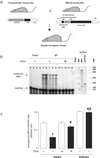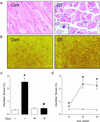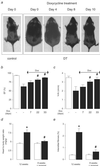Reversible cardiac fibrosis and heart failure induced by conditional expression of an antisense mRNA of the mineralocorticoid receptor in cardiomyocytes
- PMID: 11997477
- PMCID: PMC124545
- DOI: 10.1073/pnas.102673599
Reversible cardiac fibrosis and heart failure induced by conditional expression of an antisense mRNA of the mineralocorticoid receptor in cardiomyocytes
Abstract
Cardiac failure is a common feature in the evolution of cardiac disease. Among the determinants of cardiac failure, the renin-angiotensin-aldosterone system has a central role, and antagonism of the mineralocorticoid receptor (MR) has been proposed as a therapeutic strategy. In this study, we questioned the role of the MR, not of aldosterone, on heart function, using an inducible and cardiac-specific transgenic mouse model. We have generated a conditional knock-down model by expressing solely in the heart an antisense mRNA directed against the murine MR, a transcription factor with unknown targets in cardiomyocytes. Within 2-3 mo, mice developed severe heart failure and cardiac fibrosis in the absence of hypertension or chronic hyperaldosteronism. Moreover, cardiac failure and fibrosis were fully reversible when MR antisense mRNA expression was subsequently suppressed.
Figures





References
-
- Swynghedauw B. Physiol Rev. 1999;79:215–262. - PubMed
-
- Delcayre C, Silvestre J S. Cardiovasc Res. 1999;43:7–12. - PubMed
-
- Pitt B, Zannad F, Remme W J, Cody R, Castaigne A, Perez A, Palensky J, Wittes J. N Engl J Med. 1999;341:709–717. - PubMed
-
- Gomberg-Maitland M, Baran D A, Fuster V. Arch Intern Med (Moscow) 2001;161:342–352. - PubMed
-
- Lombes M, Alfaidy N, Eugene E, Lessana A, Farman N, Bonvalet J P. Circulation. 1995;92:175–182. - PubMed
Publication types
MeSH terms
Substances
Associated data
- Actions
- Actions
LinkOut - more resources
Full Text Sources
Medical
Molecular Biology Databases

